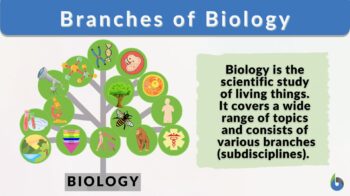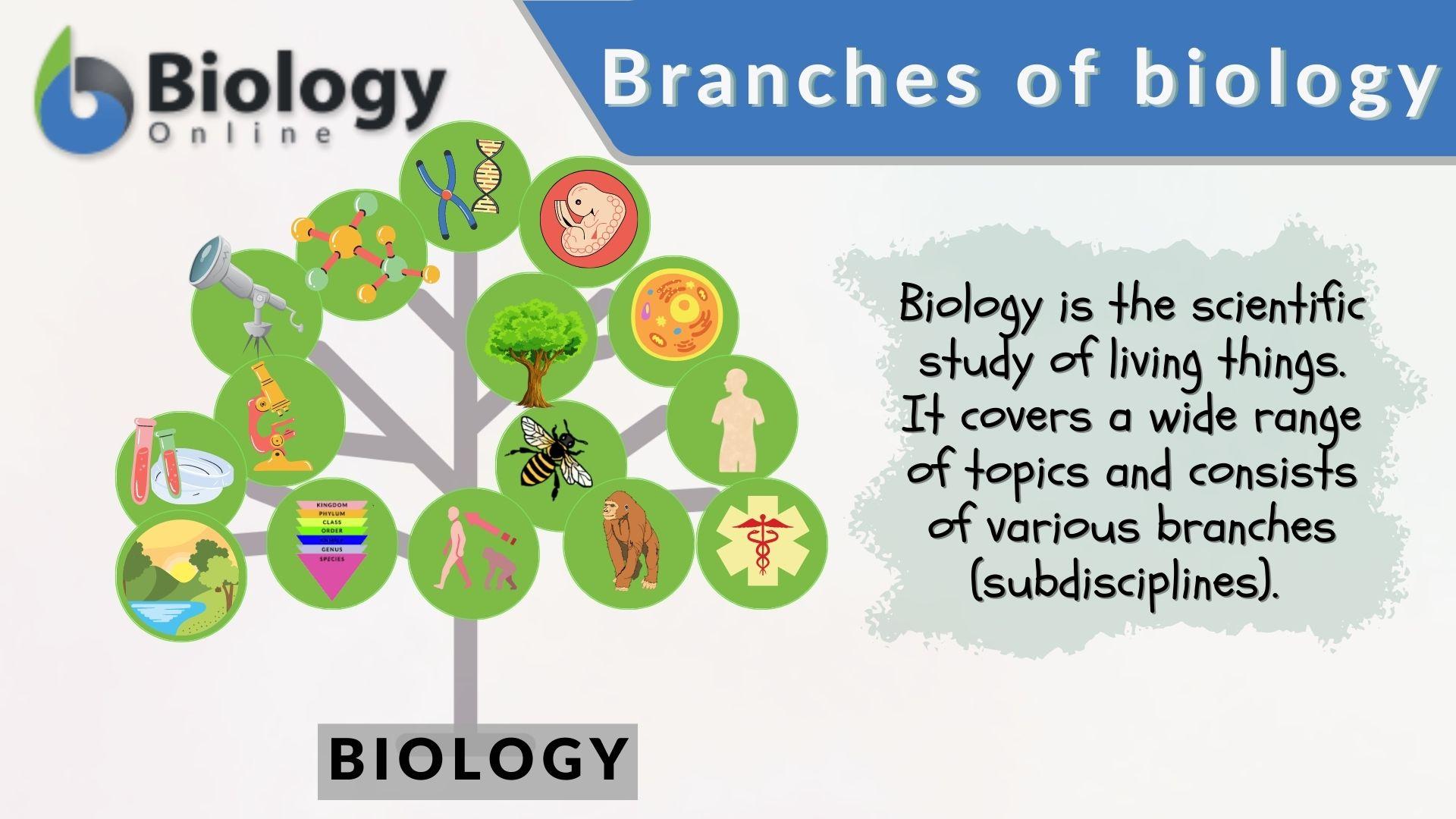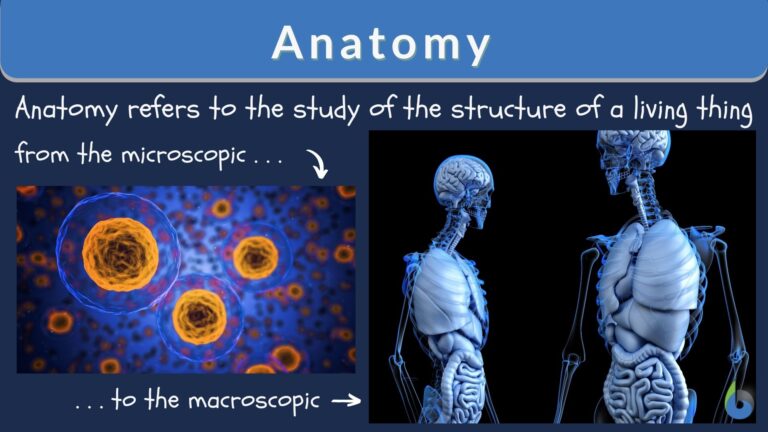
Branches of biology
n., singular: branch of biology
[ˈbɹɑːntʃɪz ɔv baɪˈɒlədʒɪ]
Definition: the diverse fields of biology
Table of Contents
What is a Branch of Biology?
A branch of biology is a specialized field or a sub-discipline in a much broader field of biology. Biology, in simple definition, is the science of life. It studies all living creatures — from the microscopic to the macroscopic life forms. A branch of biology will therefore be rooted in this definition diverging into unit components that specialize in distinct areas yet remain connected to the other branches, like a dense, ramified tree.

Branches of Biology
Biology is the scientific study of life. It includes several relevant branches. Below is a list of major branches of biological sciences with a brief description of each:
- Agriculture – the science and practice of producing trees, crops, and livestock from the natural resources of the earth
- Anatomy – the study of the animal forms, such as the human body. It is a large field that may be further divided into subfields. For instance, histology (also referred to as microscopic anatomy), in particular, deals with the study of the structure and organization of tissues and cells at the microscopic level. Comparative anatomy is concerned with the anatomy of different organisms, and comparing them to identify homology and thus understand their evolutionary relationships and shared ancestry.

Anatomy is the study of the physical aspects of biological structures, especially the internal organs. Image prepared by Maria Victoria Gonzaga of Biology Online - Astrobiology – the branch of biology concerned with the effects of outer space on living organisms and the search for extraterrestrial life.
- Biochemistry – the study of the structure, function, chemical nature (properties), and molecular and chemical interactions of biological chemicals, such as proteins, carbohydrates, lipids, nucleic acids, and other biomolecules, and of their functions and transformations during chemical reactions required for various life processes.
Tutorial: Chemical Composition of the Body - Bioclimatology – a science concerned with the influence of climates on biological organisms, for instance, the effects of climate on the development and distribution of plants, animals, and humans
- Bioengineering – or biological engineering, is a broad-based engineering discipline that deals with bio-molecular and molecular processes, product design, sustainability, and analysis of biological systems. Genetic bioengineering, for instance, is a subfield that is concerned with genetic modifications, deliberately altering the organism’s genetic material, for the desired outcome.
- Biogeography – a science that attempts to describe the changing distributions and geographic patterns of living and fossil species of plants and animals in the past and present days.
Tutorial: New Zealand’s Unique Geographical History - Bioinformatics – information technology as applied to the life sciences, especially the technology used for the collection, storage, and retrieval of genomic data
- Biomathematics – mathematical biology or biomathematics is an interdisciplinary field of academic study that aims at modeling natural biological processes using mathematical techniques and tools. It is a mathematical research integrating biology involving both practical and theoretical applications.
- Biophysics – or biological physics is an interdisciplinary science that applies the theories and methods of physical sciences to questions of biology
- Biotechnology – applied science that is concerned with biological systems, living organisms, or derivatives thereof, to make or modify products or processes for specific use
- Botany – the biological study of plants. It is a wide field that encompasses diverse biological disciplines. Thus, it could be further divided into subfields, such as plant physiology, plant anatomy, plant taxonomy, plant ecology, plant genetics, phytopathology, ethnobotany, paleobotany, phycology, bryology, palynology (study of pollen grains and spores), etc.
Tutorial: Plant Biology - Cell biology – the study of cells at the microscopic or the molecular level. It includes studying the cells’ physiological properties, structures, organelles, interactions with their environment, life cycle, division, and apoptosis.
Tutorial: Biological Cell Introduction - Chronobiology – a science that studies time-related phenomena in living things
- Conservation Biology – concerned with the studies and schemes of habitat preservation. environmental conservation, economic importance, and species protection to alleviate extinction crisis and conserve biodiversity
- Cryobiology – the study of the effects of low temperatures on living organisms
- Developmental Biology – deals with the developmental stages and developmental processes of organisms, such as how an organism develops from a zygote to its fully mature form.
Tutorial: Developmental Biology - Ecology – the scientific study of the relationships between living and nonliving matter (i.e. plants, animals, and their environment). It also considers the economic aspects and the consequences of ecosystem services, such as water purification and carbon sequestration.
- Ethnobiology – a study of the past and present human interactions with the environment, for instance, the use of diverse flora and fauna by indigenous societies
- Evolutionary Biology – a subfield concerned with the origin and descent of species, as well as their change over time, such as the evolution of the human race. It studies the evolutionary processes responsible for the diversity of life on Earth and how species have changed and adapted over time.
- Freshwater Biology – a science concerned with the life and ecosystems of freshwater habitats.
Tutorial: Freshwater Ecology - Genetics – the science that deals with heredity, especially the mechanisms of hereditary transmission and the variation of inherited characteristics among similar or related organisms. Molecular genetics is a branch focusing on the structure and function of genes at the molecular level, seeking to understand how genes are organized, replicated, regulated, and expressed within cells.
Tutorial: Genetics and Evolution - Genomics – a multidisciplinary field of biology that involves the study of an organism’s entire set of genes (genome). Human genomics, for instance, studies the sequences, structures, functions, and variations of the human genome.
- Geobiology – a science that combines geology and biology to study the interactions of organisms with their environment
- Human biology – the branch of biology that focuses specifically on the study of human beings, particularly, Homo sapiens. It covers a wide range of topics related to the structure, function, genetics, evolution, and behavior of humans.
- Immunobiology – a study of the structure and function of the immune system, innate and acquired immunity, the bodily distinction of self from nonself, and laboratory techniques involving the interaction of antigens with specific antibodies
- Marine Biology – the study of ocean and sea (marine) plants and animals and their ecological relationships
- Medicine – the science which relates to the prevention, cure, or alleviation of disease
- Microbiology – the branch of biology that deals with microscopic organisms (i.e. microorganisms) and their effects on other living organisms
- Molecular Biology – the branch of biology that deals with the formation, molecular structure biology and biological functions essential to life. A molecular biology study would primarily be concerned with biological macromolecules, such as nucleic acids and proteins and their role in cell replication and the transmission of genetic information
- Mycology – the study of fungi
- Neurobiology – the branch of biology that deals with the anatomy physiology and pathology of the nervous system. Neuroscience, as others refer to it, focuses on the structure, mental faculties, functions, development, and disorders of the brain.
- Paleobiology – the study of the various life forms existing in prehistoric or geologic times, as represented by the fossils of plants, animals, and other organisms and sometimes geographic evidence of prehistoric life
- Parasitology – the study of parasites and parasitism
- Pathology – the study of the nature, causes, processes, development, and consequences of diseases
- Pharmacology – the study of the preparation and use of drugs and synthetic medicines. It combines aspects of biology, chemistry, and medicine to understand drug properties, effects, safety, and mechanisms of action, for use as drug treatment.
- Physiology – the biological study of the functions of living organisms and their parts
Tutorial: The Human Physiology - Protistology – the study of protists
- Psychobiology – the study of mental functioning and behavior about other biological processes
- Reproductive biology – a branch of biology that focuses on the study of reproduction in organisms, focusing on the male and female reproductive organs.
- Research biology (or biological research) and bioethics – encompasses various branches and subfields of biology where systematic knowledge is gained through scientific research and biological experiments rooted in the ethical, moral, and philosophical conventions of the scientific community
- Toxicology – the study of how natural or man-made poisons cause undesirable effects in living beings
- Virology – the science dealing with viruses
- Zoology – The branch of biology that deals with animals and animal life, including the study of the structure, physiology, development, and classification of animals
Watch this video about branches of biology:
Answer the quiz below to check what you have learned so far about the branches of biology.
©BiologyOnline.com. Content provided and moderated by Biology Online Editors.




